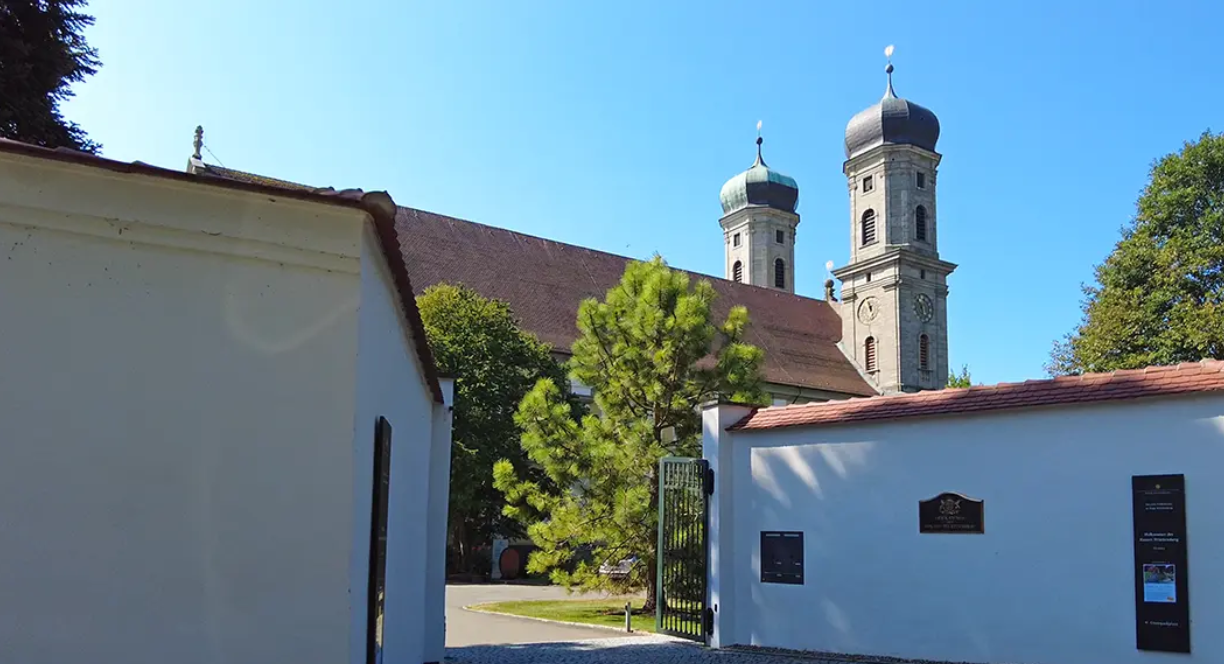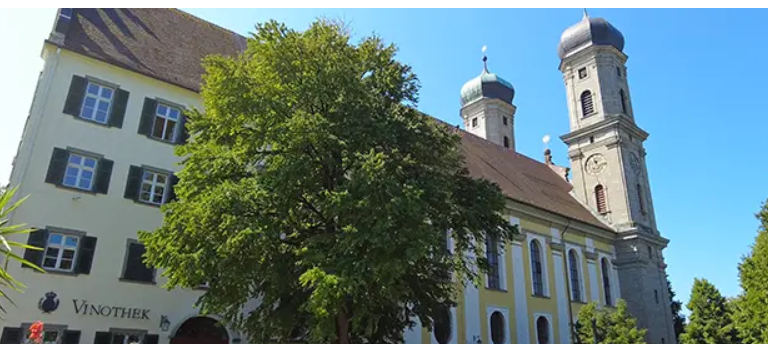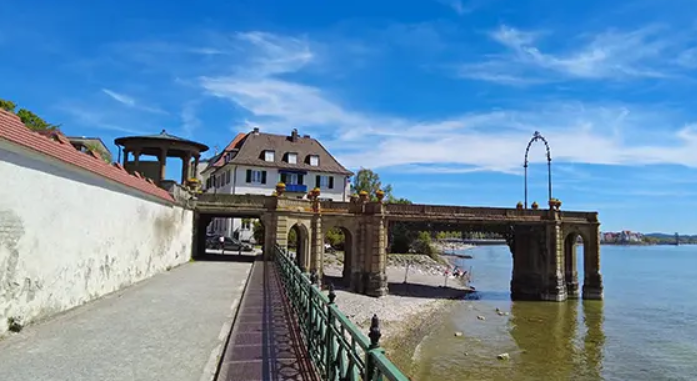Famous Upper Swabian Baroque Building on the Lake Constance Circular Trail
Address: Friedrichshafen Castle Church, Schlossstraße 1, 88045 Friedrichshafen | Built: 1695 to 1702 | Architectural style: Early Baroque | Height: 55 m
The Friedrichshafen Castle Church is a special attraction. This Evangelical Lutheran church in Friedrichshafen is located at the end of Klosterstraße. The Lake Constance Circular Trail also passes by it. The castle church was built between 1695 and 1701. Christian Thumb oversaw the construction work. The towers, both of which rise 55 meters into the sky, are particularly striking and visible from afar. Today, the castle church is one of the most famous Baroque buildings in Upper Swabia and is one of Friedrichshafen’s special landmarks.
Directions and location of this Friedrichshafen landmark
The area where the Friedrichshafen Castle Church, or the former Hofen Monastery, is located, is bordered on one side by Lake Constance and can be reached via the lakeside promenade. Schlossstrasse is on the city side, while Werastrasse, which eventually becomes Olgastrasse, is one side.
The listed building is surrounded by green spaces and trees, with scattered flowerbeds, art objects, and access to Lake Constance and the Schlosshorn. Also nearby is the castle footbridge with its old cast-iron railing, which juts impressively into the lake. A stroll along the lakeside promenade provides easy access to the Friedrichshafen Castle Church.
Opening Hours and Tours
To this day, the Friedrichshafen Castle Church and its surrounding grounds remain privately owned by the House of Württemberg. Therefore, the castle itself is not open for tours. However, the castle church can be visited.
The castle church is open for tours on certain days, allowing visitors to admire the beautiful interior design.
Friedrichshafen Castle Church Opening Hours
Friday to Wednesday:
9:00 a.m. – 6:00 p.m.
Thursday:
11:00 a.m. – 6:00 p.m.
Tours are not possible during concert preparations, religious holidays, or church services.

Admission Fees for the Friedrichshafen Castle Church
There is no admission fee to visit the church. The castle is not open to the public and therefore cannot be visited.
Guided Tours of the Friedrichshafen Castle Church
Unfortunately, there are no guided tours of the Friedrichshafen Castle Church. There are also no regular tours of the castle church, as is the case with many other monumental churches. Occasionally, themed tours can be found. With a guide in monk’s robes, interested visitors can delve into the history of the castle church, uncover hidden secrets, and hear fascinating anecdotes.
FAQ – Frequently Asked Questions about the Friedrichshafen Castle Church
When was the Friedrichshafen Castle Church built?
The Friedrichshafen Castle Church was built in 1695.
What is the Friedrichshafen Castle Church?
The Friedrichshafen Castle Church is a church in Friedrichshafen. It was built in the 17th century and serves as a Protestant church. The church is located in the immediate vicinity of Friedrichshafen Castle and is a prominent building in the city.
Can weddings or baptisms be held in the Friedrichshafen Castle Church?
Yes, both weddings and baptisms can be held in the Friedrichshafen Castle Church. As a Protestant church, it offers these religious ceremonies for members of the congregation and other believers. It is common for couples to choose the Castle Church as the setting for their wedding because of its historic and picturesque setting. Baptisms are also performed in the church to welcome children or adults into the Christian community.
Friedrichshafen Castle Church/Hofen Monastery – Special Features and Interesting Facts
Upon entering the church, numerous playful elements, unique altars, and several special features catch the eye. The intricate stucco work was created by both father and son Schmuzer and can be found everywhere from the vaulted ceiling down to the columns. While the stucco was created during the winter months, its installation in the planned location in the castle church will take place between April and October.
Walking through the nave, one is captivated by an impressive high altar and choir stalls. The high altar features twisting columns, between which lies an altarpiece by the German painter and engraver Johann Michael Feuchtmayer. The work is completed by an impressive crest by Christoph Gschanig. Other altars in the monastery church are similarly elaborately designed, and the signature of Feuchtmayer and Gschanig is also recognizable.
The choir stalls, designed by Martin Höfele, feature unique carvings and are also adorned with frescoes by Feuchtmayer. The court box is located in the southwest corner of the church building and can be accessed directly from the castle.
The paintings in the church are by Joseph Hildebrandt, an artist from Rottweil. A particular eye-catcher is the pulpit, which dates from 1702 and was created by Martin Höfele. The figures adorning the roof of the pulpit are by Ursus Byß.
There are always special features to discover in the castle church. However, sometimes a closer look is required. For those interested in ancient architecture and church art, the monastery church at the Friedrichshafen Castle Church is an absolute must.

Historical information and history of the Friedrichshafen Castle Church/Hofen Monastery
As part of the former Benedictine monastery of Hofen, it was built between 1695 and 1701. The plans for the church building were drawn up by Christian Thumb. The church was consecrated on October 8, 1702. The Imperial Monastery of Weingarten, to which Hofen Monastery belongs, was confiscated from ecclesiastical property in 1803 and transferred to Orianien-Naussau. The monastery and the monastery church were confiscated by Austria just one year later, in 1804. In 1806, Napoleon transferred the castle church and the associated monastery to Württemberg as part of the Peace of Pressburg.
The city of Friedrichshafen was founded in 1810 as part of the merger of the village of Hofen and the town of Buchhorn. Subsequently, the monastery complex and Friedrichshafen Castle Church were awarded to the Württemberg Court Domain Chamber. In 1812, the Friedrichshafen Monastery Church became home to the newly established Protestant congregation.
Up to that point, there had been no major changes to the church. Only a turret, which had been located above the building’s east wall, was removed. The confessionals were also dismantled. The castle church suffered severe damage during World War II, during a bombing raid on April 28, 1944. The roof structure was completely destroyed, and the south tower burned down completely.
A temporary roof on the church was only erected between 1947 and 1948. This was only possible with help from Switzerland. The moisture that penetrated the church over the course of approximately three years caused significant damage to the ceiling paintings and stucco work in the nave. The organ and pews also suffered severe damage from the moisture.
The church’s interior was not rebuilt until 1948. Between 1949 and 1954, Josef Schnitzler replaced the stucco during the reconstruction of the church, following original models, albeit in a simpler design. On July 1, 1951, Protestant services were once again held in the Friedrichshafen Castle Church.

Sights and attractions in the immediate vicinity of the Friedrichshafen Castle Church
Those who wish to admire and visit the Friedrichshafen Castle Church should not miss one special feature.
The castle has a footbridge on the shore of Lake Constance that resembles a bridge leading to nowhere. It is one of the most popular photo motifs in Friedrichshafen.
In the immediate vicinity of the Friedrichshafen Castle Church is the lakeside park, which invites you to explore, rest, and linger. There are numerous monuments and sculptures, some dating back to the pre-World War II period, as well as modern art objects.
A special sculpture stands directly next to the castle. It was created by Diane, Duchess of Württemberg. It depicts the guardian angel Omael, who watches over those born between August 18th and 23rd. The Duchess founded the “Diane Duchess of Württemberg, Princess of France Foundation” in 1979 and the net proceeds from her sold works of art go to the preservation of local heritage and culture at the regional level as well as to domestic and foreign aid projects to support disadvantaged children.
Cafés and Restaurants Near the Castle Church in Friedrichshafen
In the surroundings of the castle and monastery church, you can enjoy delicious wines, delicious cakes, coffee specialties, and tasty dishes to reflect on the impressions left behind by a visit to the Castle Church in Friedrichshafen and the monastery church. The castle has a wine shop where wines are also available. In a cozy atmosphere on beautifully landscaped terraces, the restaurants near the Castle Church in Friedrichshafen offer unique views of the lake and the mountain panorama.
Restaurant Ferdinand is also located on Olgastraße and has a cozy beer garden, perfect for relaxing and enjoying. The menu includes not only coffee delicacies and cake specialties, but also tasty burgers, exclusive salad creations, homemade Maultaschen (ravioli), vegan and vegetarian dishes, and many other delicious treats.
Address: Restaurant Ferdinand, Olgastraße 20
The Buchhorner Stuben on Friedrichstraße, which also includes the Buchhorner Pavilion by the lake and the wine shop, offers an extensive menu with select dishes lovingly prepared in the kitchen. You can also enjoy wines from the Weingut von Württemberg, a cold beer, or non-alcoholic beverages. There’s something for every budget.
Address: Buchhorner Stuben, Friedrichstraße 33
At the Lammgarten on Uferstraße 27, guests will find the special atmosphere of a typical beer garden. Wooden tables and chairs are an absolute must, and the regional, German, and Central European dishes on the menu promise true enjoyment. If you’re not hungry, you can also stop by the Lammgarten just for a cold beer and other refreshing drinks.
Address: Lammgarten, Uferstraße 27